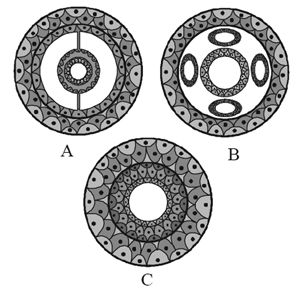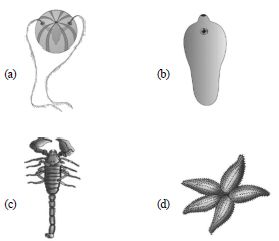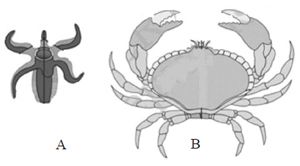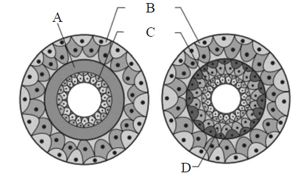A file like rasping organ for feeding, called radula, present in the phylum __________.
arthropoda
mollusca
echinodermata
chordata
Correct Answer :
B. mollusca
The radula is an anatomical structure that is used by molluscs for feeding, sometimes compared rather inaccurately to a tongue. It is a minutely toothed, chitinous ribbon, which is typically used for scraping or cutting food before the food enters the oesophagus. The radula is unique to the molluscs, and is found in every class of mollusc except the bivalves.
Related Questions
The combination of a true coelom and repeating body segmentation allows the annelids (unlike the anatomically simpler worms) to do which of the following?
Attain complex body shapes and thus locomote more precisely.
Move through loose marine sediments.
Be hermaphroditic.
Inject paralytic poisons into their prey.
A common characteristic of all vertebrates without exception is
the division of body into head, neck, trunk and tail.
body covered with exoskeleton.
the possession of two pairs of functional appendages.
the presence of well- developed skull.
Which of the following traits is not shared by both sea anemones and jellyfish ?
A medusa as the dominant stage in the life cycle.
Possession of a gastro vascular cavity.
Sexual reproduction.
Nematocysts present on the tentacles.
Which of the following is an incorrect statement regarding flatworms ?
They are acoelomates.
They are bilaterally symmetrical.
They lack a digestive system.
They have a circulatory system.
Which of the following is a correct match of a phylum with their three examples?
PlatyhelminthesPlanaria, Schistosoma, Enterobius
Mollusca Loligo, Sepia, Octopus
Porifera Spongilla, Euplectella, Pennatula
Cnidaria Bonellia, Physalia, Aurelia
Which of the following is a poisonous snake?
Naja (Cobra)
Bangarus (Krait)
Viper (Viper)
All of these
Match the types of animals given in column I with their examples given in column II and choose the correct option.
| Column -I | Column -II |
|---|---|
| (Types of animals) | (Examples) |
| A. Limbless reptiles | I. Elephant |
| B. Jawless vertebrates | II. Lamprey |
| C. Flightless bird | III. Ichthyophis |
| D. Largest | IV. Ostrich terrestrial animal |
| E. Limbless amphibia | V. Cobra |
A II; B V; C IV; D I; E III
A V; B II; C IV; D I; E III
A V; B II; C I; D IV; E III
A V; B IV; C II; D I; E III
Which of the following class is being correctly described by given statements (i - iv)?
(i) All living members of this class are ectoparasites on some fishes.
(ii) They have a sucking and circular mouth without jaws.
(iii) Circulation is of closed type.
(iv) They are marine but migrate for spawning to fresh water. After spawing, within a few days they die.
Cyclostomata
Chondrichthyes
Osteichthyes
Amphibia
Column-I contains organisms and column-II contains their exeretory structures. Choose the correct match form the options given below.
| Column- I | Column -II |
|---|---|
| (Organism) | (Excretory structures) |
| A. Cockroach | I. Nephridia |
| B. Cat fish | II. Malpighian tubules |
| C. Earthworm | III. Kidneys |
| D. Balanoglossus | IV. Flame cells |
| E. Flatworm | V. Proboscis gland |
A I; B III; C II; D IV; E V
A III; B I; C II; D V; E IV
A II; B I; C III; D V; E IV
A II; B III; C I; D V; E IV
Examine the figures A, B and C. In which one of the four options all the items A, B and C are correctly identified ?

A - Sycon, B - Euspongia, C - Spongilla
A - Euspongia, B - Spongilla, C - Sycon
A - Spongilla, B - Sycon, C - Euspongia
A - Euspongia, B - Sycon, C - Spongilla
Identify the figure with its correct name and phylum.

Cucumaria – Echinodermata
Ascidia – Urochordata
Balanoglossus – Hemichordata
Hirudinaria – Annelida
Match the characteristic feature/terms given in column I with the phylum to which they belongs given in column II and choose the correct option.
| Column-I | Column-II |
|---|---|
| (Characteristic feature/term) | (Phylum) |
| A. Choanocytes | I. Platyhelminthes |
| B. Cnidoblasts | II. Ctenophora |
| C. Flame cells | III. Porifera |
| D. Nephridia | IV. Coelenterata |
| E. Comb plates | V. Annelida |
A II; B I; C IV; D V; E III
A II; B IV; C I; D V; E III
A V; B I; C III; D II; E IV
A III; B IV; C I; D V; E II
Flame cells present in platyhelminthes, are specialized in
respiration and absorption.
osmoregulation and circulation.
respiration and excretion.
osmoregulation and excretion.
Identify the figures and select the correct option

A - Pseudocoelomate; B - Coelomate, C-Acoelomate
A - Coelomate, B - Pseudocoelomate, C- Acoelomate
A - Coelomate; B- Acoelomate; C - Pseudocoelomate
A - Coelomate; B- Acoelomate; C-Eucoelomate
Refer the figures A, B, C and D given below. Which of the following options shows the correct name of the animals shown by the figures A, B, C and D ?

A – Locust, B – Scorpion, C – Prawn, D – Pila
A – Locust, B – Prawn, C – Scorpion, D – Pila
A – Locust, B – Scorpion, C – Prawn, D – Snail
A – Butterfly, B – Scorpion, C – Prawn, D – Pila
Which of the following statements (i - v) are correct ?
(i) The pelvic fins of female sharks bear claspers.
(ii) In Obelia, polyps produce medusae sexually and medusae form the polyps asexually.
(iii) Flame cells in platyhelminthes help in osmoregulation and excretion.
(iv) In non-chordates, central nervous system is ventral, solid and double.
(v) Pinnae are present in mammals.
(ii), (iv) and (v)
(i), (iii) and (v)
(iii), (iv) and (v)
(i), (ii) and (iii)
Which of the following character is absent in all chordates?
Diaphragm
Coelom
Pharyngeal gill clefts
Dorsal nerve cord
Which of the following statement(s) is/are correct for class amphibia?
(i) Body is divisible into head and trunk.
(ii) Respiration is through gills only.
(iii) The heart is two chambered i.e. one auricle and one ventricle.
(iv) Fertilization is internal.
Only (i)
Only (iv)
(i), (ii) and (iii)
All of these
Which one of the following statement regarding coelom of given animals is correct?
Round worms (aschelminthes) are pseudocoelomates.
Molluscs are acoelomates.
Insects are pseudocoelomates.
Flatworms (platyhelminthes) are coelomates.
Which of the following animal contains respiratory organs like, gills, book gills, book lungs or tracheal system?

Click to check answer
Click to check answer
Click to check answer
Click to check answer
Which of the following characteristic is probably most responsible for the great diversification of insects on land ?
Segmentation
Antennae
Bilateral symmetry
Exoskeleton
__________ is responsible for maintaining the current of water in sponge.
Osculum
Porocytes
Spongocoel
Choanocytes
Identify the figures A, B and C and choose the correct option.

A - Male Ascaris, B - Hirudinaria (leech), C- Nereis
A - Female Ascaris, B - Nereis, C-Hirudinaria (leech)
A - Female Ascaris B- Hirudinaria (leech), C - Nereis
A - Male Ascaris, B - Nereis, C- Hirudinaria (leech)
Identify the correct characteristic feature shown by the given figure?

Diploblastic in nature.
Having radial symmetrical body.
Dioecious with direct development.
Presence of sensory tentacles on anterior head region.
Which of the following characteristics is correct for reptilia?
Body covered with dry and cornified skin, scales over the body are epidermal, they do not have external ears.
Body is covered with moist skin and is devoid of scales, the ear is represented by a tympanum, alimentary canal, urinary and reproductive tracts open into a common cloaca.
Fresh water animals with bony endoskeleton and airbladder regulate buoyancy.
Marine animals with cartilaginous endoskeleton and body is covered with placoid scales.
Match the organisms given in column-I with their common name given in column-II and choose the correct option.
| Column -I | Column -II |
|---|---|
| (Organisms) | (Comman name) |
| A. Pennatula | I. Sea-lily |
| B. Antedon | II. Sea- pen |
| C. Echinus | III. Sea-urchin |
| D. Cucumaria | IV. Sea - cucumber |
A II; C III; D I; E IV
A II; C IV; D I; E III
A II; C I; D III; E IV
A II; C I; D III; E IV
The given figures of animals (A & B) are distinguished on the basis of symmetry. Select the correct option which shows the type of symmetry and its description against the animals.

A : Biradial, organisms is divided into unequal halves by any plane through the central axis.
B: Bilateral, body is divided into equivalent right and left halves by only one plane.
A: Asymmetrical, organisms is not divided into equal halves by any plane through the central axis.
B: Radial, in which any plane passing through the central axis of the body divides the organism into two identical halves.
The figure given below shows the germinal layers marked as A, B, C and D. Identify the label showing undifferentiated layer and its location?

A, Between B & C
B, Between A & C
C, Between C & D
D, Between A & B
Which of the following belong to phylum arthropoda?
Bombyx and Apis
Laccifer and Anopheles
Locusta and Limulus
All of the above
In ctenophora, the body bears _______ external rows of ciliated comb plates, which help in locomotion.
five
six
seven
eight
